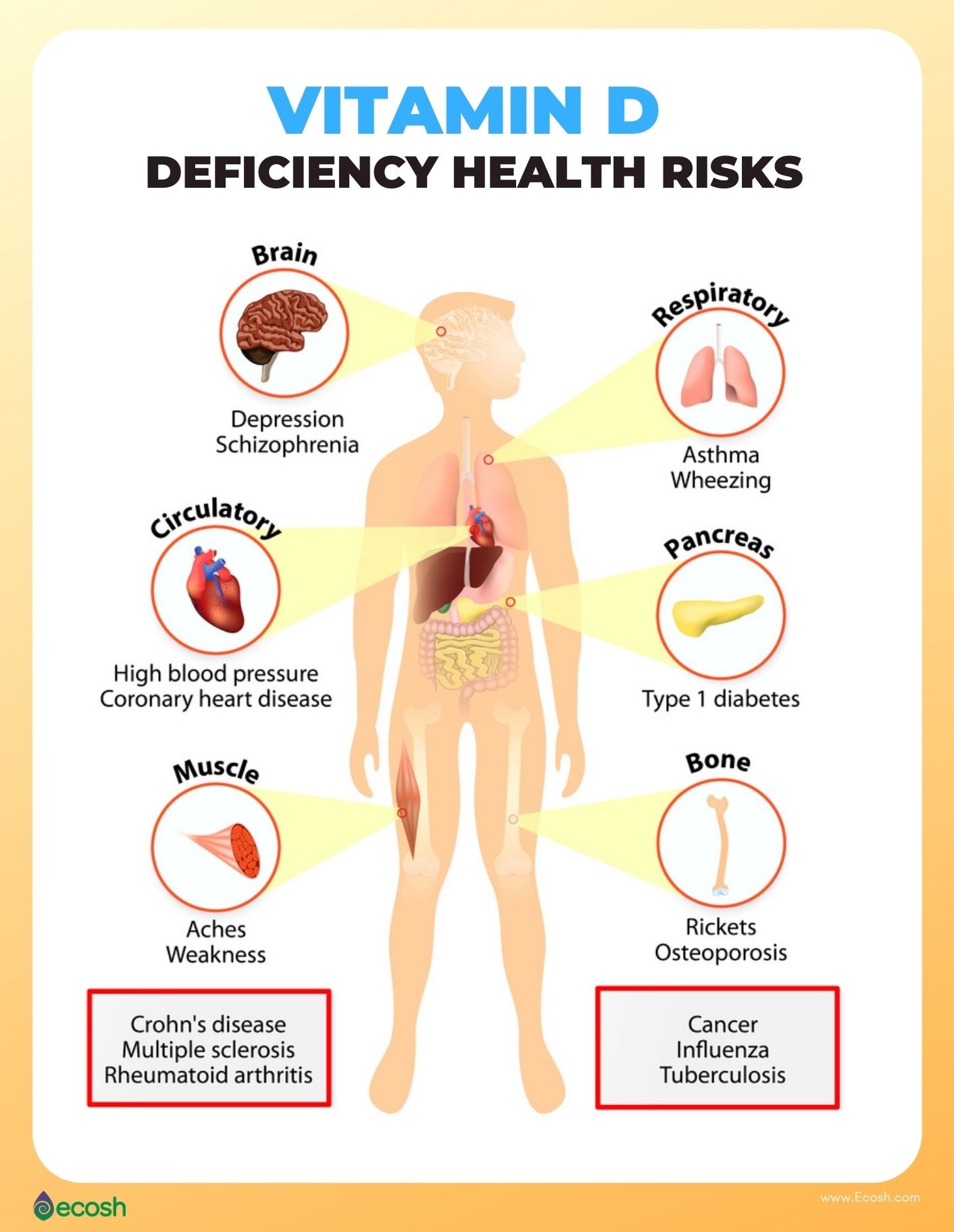Even though, sun should give all of us enough vitamin D, about half of the world’s population suffer from vitamin D deficiency. Why is it like that and what are the vitamin D deficiency signs, causes, health risks and who are the individuals most likely to suffer from vitamin D deficiency? Here in this article, you will find the answers to all of these questions.
Although according to name, Vitamin D is a vitamin, it is actually a group of fat-soluble secosteroids responsible for many biological effects in the body as well as increasing intestinal absorption of phosphate, calcium, and magnesium.
The most significant compounds in this group are vitamin D3 (also known as cholecalciferol) and vitamin D2 (ergocalciferol). Cholecalciferol is actually a highly versatile hormone in the body that is needed for several different processes in the body (1, 2).

Vitamin D Deficiency (VDD) Causes
A diet with inadequate vitamin D in conjunction with insufficient sun exposure (for example, reduced outdoor activities) may lead to vitamin D deficiency. About one billion people worldwide, across all ethnicities and age groups, have a vitamin D deficiency (VDD), and almost 50% people are vitamin D insufficient (10).
Therefore, the lack of vitamin D is an extremely important public health issue because hypovitaminosis D is an independent risk factor for total mortality in the population (10).
Some studies suggest that to prevent chronic disease – we may need even more vitamin D than currently recommended. Dietary intake of vitamin D is limited, as only few foods contain vitamin D.
Therefore, guidelines recommended supplementation at suggested daily intake and tolerable upper limit levels (10).
Vitamin D Deficiency (VDD) Signs and Symptoms
Deficiency signs and symptoms might include:
- Bone pain and back pain
- Fatigue and tiredness
- Getting sick more often
- Muscle weakness
- Muscle aches, or muscle cramps
- Mood changes
- Depression (4, 5).

Vitamin D Deficiency (VDD) Risk Factors and Risk Groups
The highest risk of vitamin D deficiency is for people who, for health or other reasons, do not exercise much outdoors without getting direct sunlight. Therefore, the biggest risk groups for vitamin D deficiency are people with a sedentary lifestyle, the elderly and people with reduced mobility. It is also important to know that with age, the body’s ability to produce vitamin D decreases significantly.
- Infants and children under 5 years.
- Pregnant and breastfeeding women.
- Adults over 65 (when aging, kidneys are less able to convert vitamin D to its active form) or when kidneys cannot convert vitamin D.
- People who have limited exposure to sunshine like office workers.
- People with darker skin.
- Inflammatory bowel disease patients.
- People with a high body fat percentage.
- Vegans and vegetarians.
- People with certain medical problems, including Crohn’s disease, cystic fibrosis, and celiac disease, as these conditions may affect your intestine’s ability to absorb vitamin D from the food.
- People taking certain medications which can all impair vitamin D metabolism.

Vitamin D Deficiency (VDD) 11 Health Risks
Vitamin D deficiency may lead to:
- Impaired bone mineralization, bone weakening and damage which leads to bone-softening diseases, including rickets in children (2).
- Extreme rickets may cause skeletal deformities and pain, failure to thrive, hypocalcemic seizures, tetanic spasms, cardiomyopathy, dental abnormalities, and in addition, may lead to developmental delay (3).
- Osteomalacia in adults and adolescents, in which existing bone is incompletely or defectively mineralized during the remodeling process, resulting in weak bones. Signs and symptoms of osteomalacia are similar to those of rickets and include bone deformities and pain, hypocalcemic seizures, tetanic spasms, and dental abnormalities (3).
- Osteoporosis. Getting enough calcium and vitamin D in childhood and teenager years may lower your risks of developing osteoporosis later in life (14).
- Cognitive impairment in older adults (6).
- Fall of the intestinal absorption of dietary calcium to 15%. While normally (when not deficient in vitamin D) individuals usually absorb between 60-80% of calcium (2).
- Increased risk of death from cardiovascular disease (6).
- Severe asthma in children (6).
- Some types of cancer. Low vitamin D levels have also been associated with an increased risk of certain types of cancer (such as prostate cancer) (6, 7, 8, 18, 32).
- In addition, getting sick more often and catching viruses. Vitamin D is known to improve the work of immune cells, including T cells and macrophages, that protect your body against pathogens and viruses (15).
- In conclusion, oral diseases. Vitamin D deficiency is highly implicated with oral diseases and has been linked with a higher risk of tooth defects, caries, periodontitis and oral treatments failure (31).
However, do not start to self medicate and consult your physician before taking any supplements or changing your current treatment, as more studies needs to be done to confirm vitamin D deficiency health risks. Read more about the amazing health benefits of vitamin D here.

Vitamin D Production, Sources and Vitamin D Rich Foods
Vitamin D2 (ergocalciferol) is produced by invertebrates, some plants, and fungi, and the production is encouraged by ultraviolet light. D3 (cholecalciferol) is produced in the skin from 7-dehydrocholesterol by the sun (or ultraviolet light UV) with an UV index of 3 or more.
However, to maintain healthy vitamin D levels in your body, you should aim to get 10–30 minutes of midday sunlight, several times per week. People with darker skin may need a little more than this (10, 11). As nowadays people stay and work more indoors, the vitamin D deficiency is very common. Therefore, to obtain sufficient amounts of vitamin D you can eat more vitamin D rich foods or take vitamin D supplements, as low vitamin D levels might increase risks for some health conditions.
The most vitamin D rich foods are for instance, cod liver oil, trout, salmon, egg yolks, sardines, mushrooms exposed to UV light and vitamin D fortified dairy products and cereals (3). Read more about vitamin D rich foods and vitamin D`s 15 amazing health benefits here.
Recommended Dietary Allowances (RDAs) for Vitamin D
The accurate level of vitamin D may be different from person to person. The only way to be sure that your vitamin D levels are where they should be is to request a 25-hydroxyvitamin D, or 25(OH)D, blood test from your GP. Preferably your blood level of 25 OH D ought to be 60ng/ml. (3).
RDA (Recommended Daily Allowance) for Children
- 0-12 months boys and girls*: 10 mcg (400 IU)/a day
- Boys 1–13 years: 15 mcg (600 IU)/a day
- Boys 14–18 years: 15 mcg (600 IU)/a day
- Girls 9–13 years: 15 mcg (600 IU)/a day
- Girls 14–18 years: 15 mcg (600 IU)/a day
RDA (Recommended Daily Allowance) for Adults 19 – 50 Years
- Men: 15 mcg (600 IU)/a day
- Women: 15 mcg (600 IU)/a day
RDA (Recommended Daily Allowance) for Adults 51 – 70 and >70 Years
- Men 51–70 years: 15 mcg (600 IU)/a day
- Men >70 years: 20 mcg (800 IU)/a day
- Women 51–70 years: 15 mcg (600 IU)/a day
- Women >70 years: 20 mcg (800 IU)/a day
RDA (Recommended Daily Allowance) for Pregnancy
- 14–18 years: 15 mcg (600 IU)/a day
- 19–50 years: 15 mcg (600 IU)/a day
RDA (Recommended Daily Allowance) for Lactation
- 14–18 years: 15 mcg (600 IU)/a day
- 19–50 years: 15 mcg (600 IU)/a day (3)
*Adequate Intake (AI) (3).

Important to Know
- Firstly, vitamin D is a fat soluble vitamin. Therefore it will absorb best in your bloodstream when taken together with high-fat foods.
- Secondly, the use of sunscreen prevents the synthesis of vitamin D in the skin.
- Thirdly, without sunscreen in the sun, the skin only produces vitamin D in the first 15-20 minutes.
- Moreover, about 50% of the human population worldwide suffer from vitamin D3 deficiency.
Micrograms (mcg) and International Units (IU) – What Does IU, mcg or µg Mean?
- IU (International Unit) – The amount of a substance that has a certain biological effect
- mcg (microgram) or µg (microgram)
- 1 mcg (or µg) = 40 IU
Health Risks from Excessive Vitamin D
Excess amounts of vitamin D are toxic and this may result in marked hypercalcemia. Hypercalcemia, in turn, may cause nausea, vomiting, muscle weakness, neuropsychiatric disturbances, pain, loss of appetite, dehydration, polyuria, excessive thirst, and kidney stones.
In extreme cases, vitamin D toxicity may cause renal failure, calcification of soft tissues throughout the body (including in coronary vessels and heart valves), cardiac arrhythmias, and even death.
However, these signs and symptoms of toxicity are unlikely at daily intakes below 250 mcg (10,000 IU) (3).
The Institute of Medicine, Food and Nutrition Board (FNB) has noted that vitamin D intakes lower than the ULs might have adverse health effects over time. Therefore, they have recommended to avoid serum 25(OH)D levels above approximately 125–150 nmol/L (50–60 ng/mL).
Moreover, even lower serum levels (approximately 75–120 nmol/L [30–48 ng/mL]) are associated with increases in rates of all-cause mortality, risk of cancer at some sites (e.g., pancreas), risk of cardiovascular events, and number of falls and fractures among older adults. (3)
NB! The information provided here is for informational purposes only, so do not consider it as health care or medical diagnosis and treatment. Do not consider this information as a guarantee of the results you want to achieve. In addition, this information here is not intended to replace the advice of your physician or other healthcare professional.
Even more, you should not use it to diagnose or treat a health problem. Before changing or discontinuing your existing medication, treatment, or care, or taking any dietary supplements, be sure to consult with your healthcare professional or doctor before starting any diet or program, or if you suspect you may have a medical condition.
Compiled by Maria-Helena Loik
Pictures: Pexels.com, Pixabay.com, Shutterstock.com


